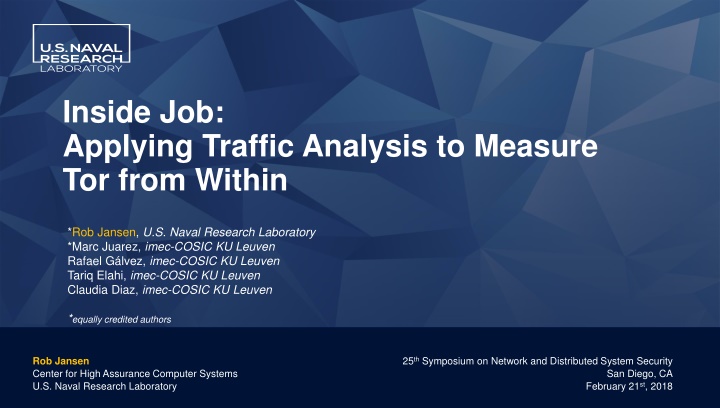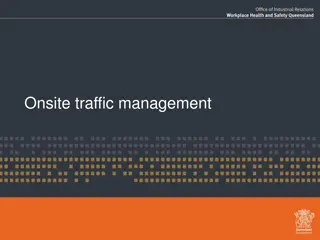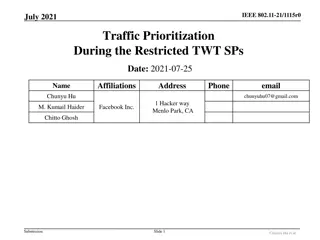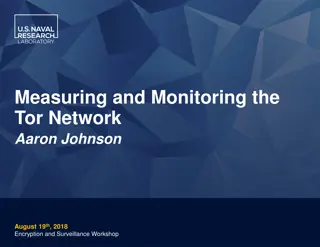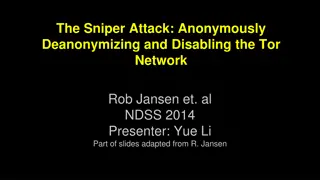Traffic Analysis for Measuring Tor from Within
Study by Rob Jansen and team explores traffic analysis techniques to measure Tor from within the network, focusing on website and onion service fingerprinting. The research examines the limitations of entry positions and advantages of middle relays in fingerprinting attacks on Tor. By considering adversaries in different network positions, the work sheds light on enhancing anonymity protections within the Tor network.
Download Presentation

Please find below an Image/Link to download the presentation.
The content on the website is provided AS IS for your information and personal use only. It may not be sold, licensed, or shared on other websites without obtaining consent from the author.If you encounter any issues during the download, it is possible that the publisher has removed the file from their server.
You are allowed to download the files provided on this website for personal or commercial use, subject to the condition that they are used lawfully. All files are the property of their respective owners.
The content on the website is provided AS IS for your information and personal use only. It may not be sold, licensed, or shared on other websites without obtaining consent from the author.
E N D
Presentation Transcript
Inside Job: Applying Traffic Analysis to Measure Tor from Within *Rob Jansen, U.S. Naval Research Laboratory *Marc Juarez, imec-COSIC KU Leuven Rafael G lvez, imec-COSIC KU Leuven Tariq Elahi, imec-COSIC KU Leuven Claudia Diaz, imec-COSIC KU Leuven *equally credited authors 25thSymposium on Network and Distributed System Security Rob Jansen Center for High Assurance Computer Systems U.S. Naval Research Laboratory San Diego, CA February 21st, 2018
Tor Website Fingerprinting Adversary s goal: use website fingerprinting to deanonymize client (link client to destination) Use traffic patterns to guess specific webpage accessed U.S. Naval Research Laboratory Inside Job: Applying Traffic Analysis to Measure Tor from Within | 2
Onion Service Fingerprinting Tor website fingerprinting on onion services Destination also runs Tor software Use traffic patterns to guess specific webpage accessed U.S. Naval Research Laboratory Inside Job: Applying Traffic Analysis to Measure Tor from Within | 3
Onion Service Fingerprinting All prior work considers adversary in an entry position U.S. Naval Research Laboratory Inside Job: Applying Traffic Analysis to Measure Tor from Within | 4
Onion Service Fingerprinting All prior work considers adversary in an entry position Limitations of the entry Client-to-entry path is an unrealistic privileged position for most Entry guard relays must be stable and have high up-time Clients choose and pin 1 entry guard for 2-3 months before switching It takes entry guards 3 months to reach steady state and be fully utilized by the network U.S. Naval Research Laboratory Inside Job: Applying Traffic Analysis to Measure Tor from Within | 5
This work: fingerprinting from middle relays Onion service fingerprinting from an internal, middle relay position U.S. Naval Research Laboratory Inside Job: Applying Traffic Analysis to Measure Tor from Within | 6
This work: fingerprinting from middle relays Onion service fingerprinting from an internal, middle relay position Advantages of the middle Clients choose a new middle for every circuit (choice is weighted by bandwidth) No special relay requirements Fully utilized almost immediately Statistical sampling of all clients U.S. Naval Research Laboratory Inside Job: Applying Traffic Analysis to Measure Tor from Within | 7
This work: fingerprinting from middle relays Onion service fingerprinting from an internal, middle relay position Middles will observe a client two orders of magnitude more quickly than guards Advantages of the middle Clients choose a new middle for every circuit (choice is weighted by bandwidth) No special relay requirements Fully utilized almost immediately Statistical sampling of all clients U.S. Naval Research Laboratory Inside Job: Applying Traffic Analysis to Measure Tor from Within | 8
This work: fingerprinting from middle relays The middle identifies the destination and then what? Onion service popularity measurement [this work] Client geolocation attack using latency [Hopper et al. 2007,2010] Fingerprint protocols instead of websites [future work] Targeted attacks on guards that are used to access websites of interest [Jaggard and Syverson, 2017] U.S. Naval Research Laboratory Inside Job: Applying Traffic Analysis to Measure Tor from Within | 9
Outline Background, Motivation: Why the middle relay? Circuit fingerprinting Onion Service Fingerprinting Onion Service Popularity Measurement Conclusion / Questions U.S. Naval Research Laboratory Inside Job: Applying Traffic Analysis to Measure Tor from Within | 10
Circuit Fingerprinting Collect circuit traces, extract features, train classifiers Identify circuit purpose and position
Circuit Fingerprinting Predict circuit type and relay position Binary classification Circuit purpose: rendezvous (onion service) Circuit position: middle (adj. to guard) U.S. Naval Research Laboratory Inside Job: Applying Traffic Analysis to Measure Tor from Within | 12
Data Set, Features, and Training Generate samples using Shadow Use the Shadow Tor simulator to generate 1.85 million circuits Label circuits with purpose and position Extract features and train random- forest classifiers Use as features: Previous/next node type Counts of cell type/relay command (recv/sent inside/outside) U.S. Naval Research Laboratory Inside Job: Applying Traffic Analysis to Measure Tor from Within | 13
Circuit fingerprinting results U.S. Naval Research Laboratory Inside Job: Applying Traffic Analysis to Measure Tor from Within | 14
Onion Service Fingerprinting Collect webpage traces, train and evaluate classifiers Identify onion service
Onion Service Fingerprinting Given a rendezvous circuit, can we identify the destination? Run modified Tor to identify circuits that we originate! Crawl known and online onion sites Capture TCP trace with tshark 2,500 onion sites, 80 crawls per front page Capture cell trace with onionperf U.S. Naval Research Laboratory Inside Job: Applying Traffic Analysis to Measure Tor from Within | 16
Closed World Onion Site Fingerprinting Results True Positive Rates Entry model Classify using client-to- guard packet traces Middle relay model Classify using middle relay cell traces U.S. Naval Research Laboratory Inside Job: Applying Traffic Analysis to Measure Tor from Within | 17
Open World Onion Site Fingerprinting Results One-class classification problem Site is the monitored site or other We used a popular social networking site ( ) as the monitored site Projection shows boundary that minimizes false positives 80% of all errors were from 12 sites U.S. Naval Research Laboratory Inside Job: Applying Traffic Analysis to Measure Tor from Within | 18
Open World Onion Site Fingerprinting Results Base Rate Performance Precision is 50% at a base rate of 1% Precision decreases exponentially with the base rate U.S. Naval Research Laboratory Inside Job: Applying Traffic Analysis to Measure Tor from Within | 19
Onion Service Popularity Measurement Train classifiers on a social networking site front-page Apply trained classifiers to measure onion service popularity using privacy-preserving Tor measurement tool (PrivCount)
Classifying Circuits and Sites in Tor Measured popular social network site that runs a single onion service Enhanced PrivCount to classify circuit purpose, relay position, and site facebookcorewwwi.onion Three measurements: Classify circuits from real Tor users Classify circuits from ground truth crawler Measure direct accesses to the ASN of (in the cases that we are the 3rd hop) U.S. Naval Research Laboratory Inside Job: Applying Traffic Analysis to Measure Tor from Within | 21
Classifying Circuits and Sites in Tor Measured popular social network site that runs a single onion service Ethical research: PrivCount provides differential privacy and secure aggregation of results Enhanced PrivCount to classify circuit purpose, relay position, and site facebookcorewwwi.onion No information is stored on disk Three measurements: Classify circuits from real Tor users Classify circuits from ground truth crawler Measure direct accesses to the ASN of (in the cases that we are the 3rd hop) Consulted with Tor Research Safety Board to get feedback on methodology Circuit-specific information is stored only for the life of the circuit (10 minutes) U.S. Naval Research Laboratory Inside Job: Applying Traffic Analysis to Measure Tor from Within | 22
Classification Results Classifier Purpose Position Site True Positives 100% 96.5% 60.0% False Negatives 0% 3.4% 40.0% Crawler results (ground truth) Popularity Purpose (onion service) Site Direct 1.28% 0.52% Classified 4.48% 0.02% Measurement pipeline results Results include noise! U.S. Naval Research Laboratory Inside Job: Applying Traffic Analysis to Measure Tor from Within | 23
Conclusion Circuit and website fingerprinting is at least as accurate from middle relays as it is from the entry position The number of Facebook onion site visits was indistinguishable from noise More work needed to better understand middle relay threats Contact: Rob Jansen U.S. Naval Research Laboratory rob.g.jansen@nrl.navy.mil robgjansen.com, @robgjansen All code is open-source: github.com/onionpop github.com/privcount github.com/shadow U.S. Naval Research Laboratory Inside Job: Applying Traffic Analysis to Measure Tor from Within | 24
Onion Service Fingerprinting Classifiers Train and test well known classifiers using packet and cell traces k Nearest Neighbors (kNN) [Wang et al., 2014] Averages over k closest instances according to Euclidean distance CUMUL [Panchenko et al., 2016] Support vector machine (SVM) with radial basis function k-Fingerprinting (KFP) [Hayes and Danezis, 2016] Random forest + kNN (with Hamming distance) U.S. Naval Research Laboratory Inside Job: Applying Traffic Analysis to Measure Tor from Within | 25
